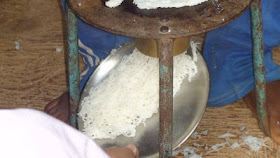

Ingredients:
Raw white rice - 3 cups
Water - 6 cups (1:2 ratio of rice & water)
Salt to taste
Semige Presser
Oil - 6 tsps
Method:
Soak the rice in water, overnight. Wash the rice & drain the water. Now grind the rice in a mixie or grinder with water & salt to taste. The ground mixture should be smooth textured & in the consistency of dosa or idli batter.
Place a heavy bottomed vessel on medium flame. Heat 5 tsps of oil. To that add the ground mixture & keep stirring continously to prevent the formation of lumps. Keep stirring till all the water evaporates & you get a chapati dough consistency. Remove the vessel from fire & let it cool a bit so that you would be able to handle the dough by your hands.
Unlike the Akki Pundi (Rice Dumplings), where we made small balls of the dough, here we make similar balls in a lengthy cylindrical shape say of about 4-5 inches in length & thickness of about 1.5 inches. If it tends to stick on to your hands, just wet your hands with a little water & continue the process. Now place these cylindrical shaped doughs in a steamer & steam cook till done. Say about 15-20 minutes. Otherwise just prick these doughs with a fork to check if it sticks on to it. if it does let it cook for some more time. If not, it is understood that it is well cooked. Now remove it from fire.
Do not let it cool down, as we need it piping hot to press it down the presser. Smear the cylindrical mould with oil ( preferably coconut oil, or refined would also do) to prevent it from sticking on to it & helping the dough to get pressed down easily. With the help of tongs, remove a cylindrical shaped dough from the steamer & place it in the cylindrical mould. Immediately start rotating the handles, which has a hard cylindrical shaped roll attached to it. As you rotate, this roll would push itself down into the cylindrical mould which would inturn press the dough down. Beneath, a plate should be placed in order to recieve the pressed semige which comes in the from of thin strands as the cylindrical mould is perforated.
No comments:
Post a Comment